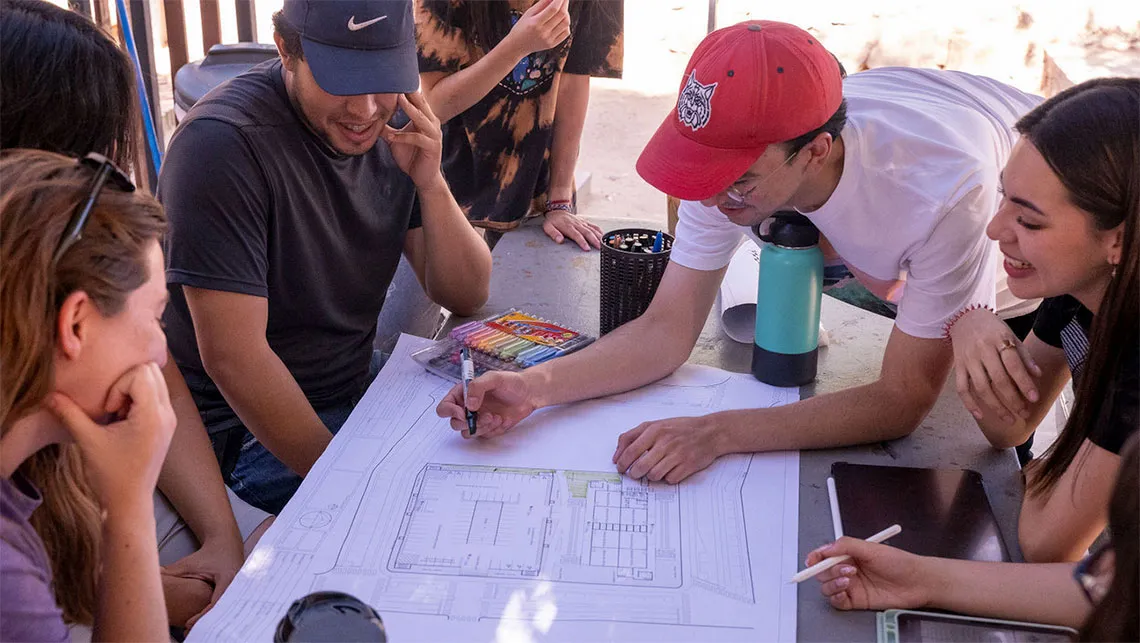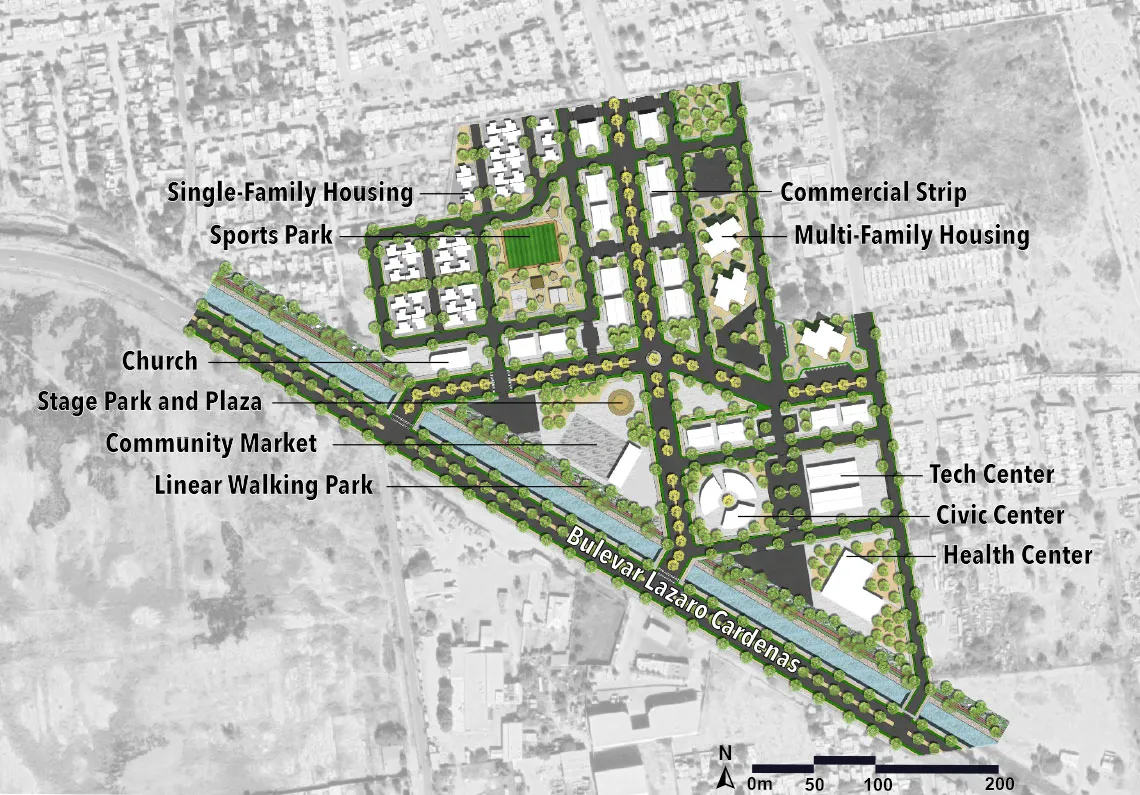‘Spanning Boundaries Challenge’ Grant Unites Design Students from Arizona and Sonora
Exploring Green Infrastructure in Hermosillo: A Cross-Border Collaborative Studio

University of Sonora students during a tour of green stormwater infrastructure in Tucson's Dunbar/Spring neighborhood. Photo by Aaron Bugaj.
Located 250 miles south of the University of Arizona, the city of Hermosillo in Sonora, Mexico, has the opportunity to become a hub for sustainable design. Thanks to a 2022 Center for University Education Scholarship Spanning Boundaries Challenge Grant, landscape architecture and architecture students from UArizona and the University of Sonora (UNISON) came together last semester to further explore green infrastructure in the capital city of Sonora.
The grant was awarded with the goal of embedding civic engagement and service learning into existing courses by engaging students, faculty and borderland communities in community-driven research around sustainable food and water solutions. The “existing course” in this case was an urban design studio led by Kenneth Kokroko, assistant professor of landscape architecture in the College of Architecture, Planning and Landscape Architecture. The design studio resulted in student work that is “a testament to the power of cross-disciplinary and cross-border collaboration in the built environment,” says Kokroko. The studio likewise resulted in an inspiring array of sustainable design solutions created by the students to address complex challenges in arid environments.

UNISON and CAPLA students work on a project at the University of Sonora in Hermosillo. Photo by Aaron Bugaj.
A Unique, Collaborative Journey
Three classes—two undergraduate architecture classes from UNISON and a Master of Landscape Architecture class from UArizona—joined forces on a journey that exemplifies the importance of collaboration, innovation and sustainable practice. The effort involved six groups of students, uniting their interests and evolving skillsets to tackle multifaceted design challenges.
One of those UArizona students was Will Leipold ’24 MLA. “This was our first experience collaborating with architecture students to produce a cohesive design,” he says. “It was also incredible to be immersed in such a different culture and to see how the urban design process is approached in Mexico.”
During the semester, students undertook an extensive research phase, delving into best practices in sustainable design and green infrastructure. Their focus was not solely on theory but also on tangible solutions that could be implemented in practice. From this foundation, they surveyed existing development requirements in Hermosillo and proposed new design guidelines to bolster sustainable development. This groundwork set the stage for their master planning of a mixed-use district within an underserved community, a process that required meticulous attention to detail and a keen understanding of the local context.
Throughout the project, students were able to collaborate despite the challenges posed by remote interaction. The majority of the work was completed virtually, a feat that demonstrates their resilience and adaptability—a crucial skillset for future built environment professionals.
“After participating in the studio, not only do I feel better equipped to enter the professional field of landscape architecture, I now also have a much greater appreciation for the profession and its profound impact on the environment,” says Leipold.

Site assessment for project in Hermosillo, Sonora, Mexico, by Will Leipold.
International Connections and Enriching Experiences
The studio’s uniqueness was further amplified by its cross-border interactions. UArizona students made two trips to Hermosillo, engaging in brainstorming sessions with UNISON counterparts and immersing themselves in the city’s sustainable design projects. These visits also facilitated interaction with community members, allowing students to learn about grassroots efforts aimed at enhancing green stormwater infrastructure and urban greening.
The exchange was reciprocal, as UNISON students and faculty journeyed to Tucson to participate in similar activities. These shared experiences spanned cultural divides and fostered a deeper appreciation for collaborative endeavors.

Students collaborating on a project in Hermosillo, Sonora. Photo by Aaron Bugaj.
Nurturing Collaboration in Design
At its core, this project sought to instill a culture of collaboration—an ethos that goes beyond disciplines and geographical boundaries. The collaborative spirit extended not only to the students but also to the institutions, community groups and faculty members.
“The success of this studio underscores the significance of teamwork for design professionals,” says Kokroko. “In a world where challenges are increasingly complex, solutions often demand a diverse range of perspectives and expertise. The students emerged from this experience equipped with both technical skills and the ability to navigate the intricacies of collaborative projects.”

CAPLA and UNISON students work with Caminantes del Desierto community organization volunteers in Hermosillo, Sonora. Photo by Aaron Bugaj.
It Takes a Village
The success of the cross-border studio would not have been possible without the support of numerous individuals and entities. In addition to Kokroko, the Spanning Boundaries Challenge team is comprised of Caitlyn Hall, assistant professor of practice in biosystems engineering; Nicole Antebi, assistant professor of illustration and animation; Aaron Bugaj, senior research specialist at Biosphere 2; Lysette Davi, project manager at Arizona International; and Laura Horley, director of marketing and communications at the W.A Franke Honors College. UNISON faculty leadership was provided by Rosa Maria Mendoza Robles and Luisa Maria Gutierrez Sanchez.
CAPLA and UNISON’s Department of Design shared a commitment to nurturing cross-border collaboration and fostering innovative educational experiences. Yet the project would not have been possible without community groups such as Caminantes del Desierto, which provided an invaluable context for sustainable development efforts in Hermosillo.
“And let’s not forget the students themselves, who deserve the highest recognition,” says Kokroko. “Their dedication, creativity and perseverance produced an inspiring body of work that showcases their commitment to sustainability, design excellence and collaboration.”

Site plan for a sustainable development in Hermosillo, Sonora, proposed by CAPLA and UNISON students. Rendering by Will Leipold.
A Glimpse into a Sustainable Future
The collaborative effort between the UArizona and UNISON stands as a testament to the power of shared vision, cross-disciplinary synergy and international cooperation. The design solutions born from the students’ work offer a glimpse into a future where innovation, collaboration and design intersect to create a more sustainable and harmonious built environment.
Kokroko is undertaking the next iteration of this successful cross-border studio next semester. To prepare, he is assembling a list of lessons learned that can be applied to an array of future studios and which are a part of the team’s research on design education more broadly.
“As these lessons ripple outward,” concludes Kokroko, “they have the potential to inspire similar borderland ventures worldwide—shaping a future where boundaries are not barriers but rather are bridges to progress.”
Learn more about the UArizona Master of Landscape Architecture program, or discover how you can support faculty and studio projects.



